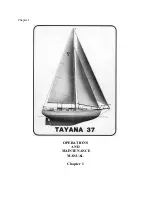
Windlass Breaker
In addition to DC panel switches, there is an Anchor
Wlndlass switch right of the helm. Have it “ON" only when using
the windlass.
Small DC Breaker Panel
This panel is located low, to the right of the helm. It has two breakers, for the
stabilizers and autopilot. See their instructions below.
4G7: Xantrex DC Power Monitor
On the left side of the helm cabinet is a Xantrex DC
Energy Monitor. This nifty unit allows you to check DC
house battery voltage, charging/use rates in amps, and
approximate cumulative battery energy used.
The display has “step” LED’s that indicate the state
of the batteries’ charge, from “empty” (on the left) to “full”
(on the right).
There are three buttons on this unit’s panel, “V”,
“A/Ah” and “%”.
“V”, “Volts” mode:
Unit displays the house battery voltage. The
“volts” mode with 12.8 fully charged (nothing
running); 14.2 or more bulk charging; 13.2 - 13.8
float charging, less than 10.0 volts, (discharged.)
“A”, “Amps” mode:
Unit displays the rate of charge or discharge of the house batteries; a “-” sign appears when
the battery is discharging, no sign when charging.
“Ah”, “Amp-Hours” mode:
Unit is like a “fuel gauge in reverse”. Batteries fully charged, the unit show approximately
“0". As ampere-hours are used, the unit counts how many, i.e., after you’ve used 50 amp-
hours, the unit will display “-50" or so.
The amp-hours readings are approximate, and relative. When you run
the boat, the number should decrease again to zero. In fact, the most
useful setting for the energy monitor is the amps mode, which answers
the question “Am I using up (-) or adding power to the batteries right
now?”
Windlass
Breaker.
Small DC Breaker Panel
Section 4G: Electrical Systems, DC 4.17
















































